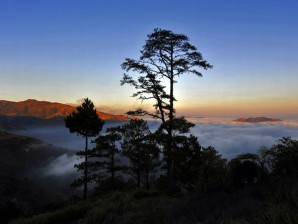Easterlies blamed for fickle weather

CHILLING. The so-called 'ber' months bring cool temperatures to Benguet, which motorists experience as they travel through Halsema Highway. The cold weather sometimes brings actual frost, towards January and February. PHOTOS BY EV ESPIRITU/NL
MANILA, Philippines—Some mornings it gets very cold. By mid-morning, the heat is almost searing. And it gets weirder by the day.
Weather forecasters say the fluctuations in temperature are caused by the easterlies, or the trade winds near the equator moving from east to west in the lower latitudes, and the transition of the monsoons.
The easterlies, which bring warm and moist air from the Pacific Ocean, are the dominating wind pattern as the seasonal winds transition from the southwest monsoon (habagat) to the northeast monsoon (amihan), explained forecaster Raymond Ordinario of the Philippine Atmospheric Geophysical and Astronomical Services Administration.
“During the transition, the weather is most erratic,” Ordinario said.
“During the transition period, we experience fluctuations of cold and hot weather. That’s normal. The distribution of temperature is not uniform,” he said.
According to Ordinario, it could take a couple more weeks before the easterlies yield to the northeast monsoon, or amihan, which brings the cold, dry air from Siberia around this time of year, which most Filipinos associate with the advent of the Christmas season.
The easterlies have some good effects though, Ordinario said.
Enhanced by a La Niña-like phenomenon, they bring rain over the eastern part of the country facing the Pacific Ocean but not on a sustainable basis. They also develop strong “vertical windshears” that prevent the formation of cyclones, he said.
“That’s what happened after typhoon `Juan’ last year. We didn’t have cyclones because of the strong easterlies,” he said.
Pagasa expects one or two cyclones to enter the Philippines this month, but sees no low-pressure area on the horizon in the next 72 hours.
“So generally, we’ll have fair weather in most parts of the country,” Ordinario said.
Pagasa earlier said that the amihan has crept into extreme northern Luzon.
But Ordinario said the high pressure area in Siberia was not “strong enough” yet to bring cold, dry air to Asia, particularly China, Taiwan and the Philippines.
“It should be fully developed for us to experience amihan,” he said.
Meanwhile, an intertropical convergence zone (ITCZ) over Mindanao would continue to bring mostly cloudy skies and scattered rainshowers over the area, Pagasa said.
Originally posted: 6:32 pm | Wednesday, November 9th, 2011














